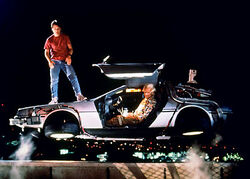That's a possibility. Here's the TimesOnline: The article has really generated the comments. The first one is the best:
The article has really generated the comments. The first one is the best:
Picture of the DeLorean with Marty and Doc from Back to the Future 2.
Ian Poll, Professor of Aerospace Engineering at Cranfield University, and head of technology for the Government-funded Omega project, is calling for a big research programme to help the aviation industry convert from fossil fuels to nuclear energy.
...
“If we want to continue to enjoy the benefits of air travel without hindrance from environmental concerns, we need to explore nuclear power. If aviation remains wedded to fossil fuels, it will run into serious trouble,” he said.
 The article has really generated the comments. The first one is the best:
The article has really generated the comments. The first one is the best:As soon as I started reading this, one picture immediately came to mind: Marty McFly standing next to the Delorean and asking Doctor Emmett Brown, "This thing is NUCLEAR!!??"Hat tip to Eric McErlain.
Yep, whatever the mind of man can conceive and believe, it will achieve...
Picture of the DeLorean with Marty and Doc from Back to the Future 2.
Comments
And the shielding would have to be such that customers sitting 10 feet from the reactor, and their luggage, get virtually no exposure.
Sure, you can undoubtedly build a reactor to do that, but whether you can build a reactor small, light, and powerful enough to provide a practical power source is pretty doubtful.
Shipping faces the same emissions issues as air travel, doesn't have the extreme power density requirements, and doesn't have nearly the same NIMBY factors. For those reasons, nuclear powered shipping is a much better bet. Furthermore, a couple of decades of safe, reliable nuclear-powered shipping might make more ambitious things like nuclear aircraft more politically plausible.
If that is true, nuclear aircraft are politically more plausible now. Nuclear ships are acceptable, even to Greenpeace for their own workers' transportation.
I don't think you have to "demonstrate that the working reactor could cope with an air-to-air missile". A passenger aircraft is in deep trouble if it's attacked with an anti-aircraft missile anyway, and in such an event, there's a high likelihood that all persons on board will be killed, and that's equally true with or without a nuclear power system.
What you need to evaluate, I think, is that if a nuclear powered aircraft were to be shot down, what would the health physics implications be for the people on the ground? The people on the aircraft are already dead, but how much dose would be picked up by those on the ground?
Haven't we already had several decades of safe, reliable shipping both above and below water? I think cargo of 5,000+ people, a hundred fighter jets and nuclear warheads should count as "shipping."
If a reactor on a ship fails, the ship drifts. If a reactor on an AIRPLANE fails, it falls out of the sky and everyone dies.
Now about the "everyone dies" part...which everyone are you talking about? Everyone on a sinking nuclear sub dies? Almost everyone on a conventional plane dies in a crash. If this hypothetical aircraft reactor is properly designed, the only ones that die are the ones it physically lands on, same as a conventional aircraft engine.
Personally I still don't think it's feasible.
And perhaps I needed to add the caveat "civilian" in front of shipping. A lot of people (particularly on the left of politics) seem to believe that while the US Navy can run reactors safely, private operators inherently can't.
I still don't think it's feasible.
Please elaborate. What might have to change to make it feasible?
--- G.R.L. Cowan, H2 energy fan 'til ~1996
In shipping you are looking at hauling more stuff, less people. In a plane we're usually talking about the other way around.
The upfront costs of such a plane would be astronomical (just look at what a submarine costs). I don't think a private company would be able to balance that level of financial risk with the long term return.